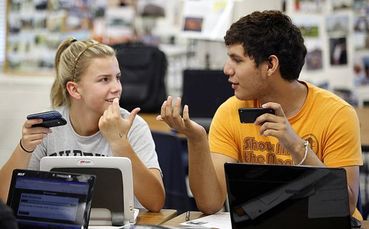
Like it or not, BYOD (Bring Your Own Device) is the future of learning, largely because schools lack the money to support 1:1. Educators have recognized the significance and necessity of mobile devices for this generation of tech-savvy learners. It just makes sense. Mobile learning not only promotes increased collaboration and engagement, it’s also preparing students for their future careers which will inevitably include utilizing these devices. The benefits of BYOD in schools are endless.

Today I want to cover the school wireless network infrastructure requirements for BYOD success. The first step and most vital step in any BYOD implementation is always making sure your school wireless network is equipped to handle all these mobile devices securely and successfully. You can’t just allow everyone to bring in their mobile devices to school and let them have access. You will have too many devices for your infrastructure. If your wireless network sucks all the planning and policies in the world don’t even matter. So preparing your school wireless network appropriately is central to BYOD success.
Here’s your list of the 4 key school wireless network infrastructure requirements every school considering BYOD must take into account.
Role-Based Access Control (RBAC)
School wireless networks supporting BYOD must be able to segment users based upon who they are as well as what type of device they’re using. Based on role you can segment users into groups to limit what they can access. For example, you can use RBAC to give students access to the internet with web-content filtering, but keep them off internal servers.
Capacity vs. Coverage
In today’s school environment the old coverage model for wireless network won’t cut it. They just don’t have the ability to handle the new requirements. In k-12, schools can expect 1-2 devices per student. In higher education its 3-5 wireless devices per student.
Application-Level Filtering
Next-generation firewalls know what applications your student and teachers are using and what sites they are trying to access. This is important, because it gives you the ability to write a policy for the groups of users that relates to what they do online including how much bandwidth they are allowed to use. For example, you can create a policy that limits the bandwidth students are allowed to use when on YouTube so they don’t interfere with the teacher using Moodle.
Directory Services and Device Registration
For BYOD you will need to have a database of the users, groups, and the devices registered to each user. The identifications created for each user in your directory should also be used to validate the user on your school wireless network so that you have a single database of users accessing the network.
These 4 requirements should be a part of any school wireless network supporting BYOD. There’s a lot to consider, so to make the whole BYOD implementation process as painless as possible, make sure you choose a good wireless design specialist. Gartner has estimated: 80 percent of newly installed wireless networks will be obsolete by 2015 due to improper or insufficient planning.





![1:1 or BYOD in Schools? Which is Better for You [Infographic]](https://techgrid.com/hs-fs/hub/80068/file-2178602454.jpg)
